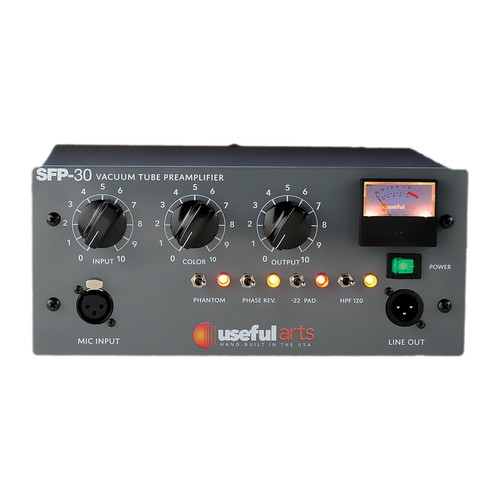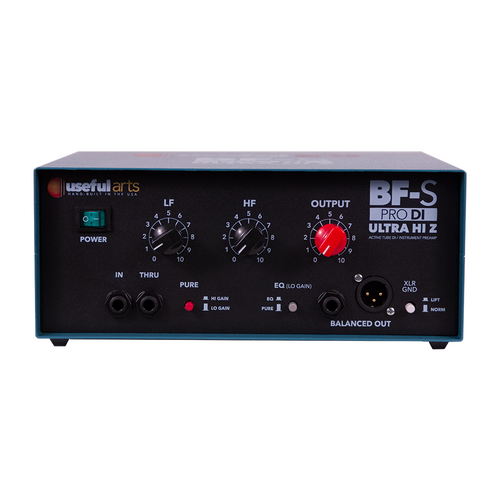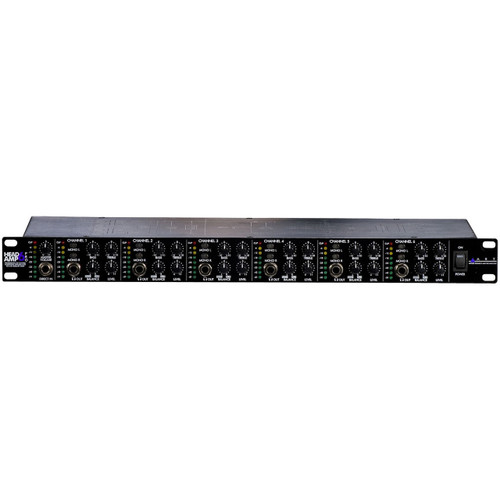The SFP-60 is a two-channel, full-featured all-tube mic pre designed to make microphone signals pop in a mix without the need for other enhancement. We view the microphone and the preamplifier as a single unit - the signals coming out of a microphone are useless by themselves, and we only know what the microphone is doing after the signal is presented by the preamp. It seems a shame to use a great microphone and never hear the majesty of its sound, so we designed the SFP-60.
It’s easy to get relatively clean, flat sound out of a preamp costing a fraction of the price – the preamp in your phone does an astonishingly good job of that. And to most ears, the bare sound of a signal from an average microphone through an average preamp, standing by itself, is pretty good. Yet dropped into a mix, that perfectly "fine" sound is dead, lifeless and lost. So begins the cycle of processing, the quest for the one magic box or plugin (or series of them) that will make things sound like they're supposed to. The result is usually a louder, heavily-effected but even more lifeless signal that can't quite find its place in a mix.
It turns out that fewer, not more, knobs and buttons are the key to incredible sound. In the early days of recording, the overprocessing phenomenon didn't exist. Records were recorded to one or two tracks, and whatever was heard in the room during the performance was heard by the public - simple as that. And it sounded great -- with no post processing at all. The key was that the sound was preserved in all its natural glory before recording. It's a lot like the difference between fresh food and microwaved food.
In a preamp, we are looking for a creative tool that complements the other main tools available: EQ, compression and time-based effects. None of those tools can make one preamp sound like another. So let’s get to what’s going on under the hood.
The sound of the SFP-60 is more clear, present and edgy than dark and creamy, and is specifically designed to make vocals sound forward and intimate. We accomplish this by using tubes for what they are best at – accentuating harmonics that make sound more clear and pleasing to the ear and brain in the real world. Different tubes have different properties. Properly used, pentodes add third-order harmonic content that contributes the the “clarity” and “bite” associated with the sounds of the great early radio recordings. Triodes contribute more second-order harmonic components, which add a richness, or “thickness” to the sound without sounding dark. (Note: These are subjective impressions. People can and do debate these adjectives for a lifetime). The SFP-60 input tube is an EF-806 pentode, and the final 2 gain stages are high-current ECC82 triodes. 12AX7s, which are wonderful in guitar amps and form the basis of many mass-marketed tube mic preamp circuits, are nowhere to be found in the SFP-60.
The character of the harmonic distortion in a preamp has a spectral effect that we intuitively think of as EQ-related, but in reality is completely different from EQ. EQ filters give you more or less of what you put in (and normally introduce undesirable phase shifts too), while the preamp is actually adding signal that isn’t present in the original signal. Because this addition is not a perfectly faithful reproduction of the input signal, it’s called distortion (even though it sounds nothing like the clipping distortion generated by a guitar amplifier). Every audio device that has ever been made introduces distortion, so we might as well make it a good thing.
It turns out that distortion can be quite useful. Every sound we record will have to be reproduced by a mechanical speaker of some sort, and the right kind and amount of distortion can actually help the speaker do its job by compensating for the inadequacy of the reproducing device. In this way, distortion can actually help make a recorded sound seem more real at playback.
Enter the color knob on the SFP-60. Unlike most preamps, which are designed to maintain a predetermined ratio of distortion to gain, the SFP-60 puts the artistic choice of distortion in your hands. At a setting of 0, the preamp is very, very clean – it sounds “polite.” A setting of 10 will add about 10db of gain and increase the distortion artifacts by nearly ten times. The result is an agressive, full sound that stands out in a mix and grabs the listener's attention. That’s an incredible creative range, and it gives the SFP-60 the ability to offer very different sounds for different tracks and different sources.
How do we do this? We load the output tube with a massive inductor (custom wound by Cinemag) rather than a resistor -- the same technique used in the design of classics like the Telefunken V76. Sure, a resistor costs a few cents and that one inductor costs us nearly $40.00 per channel. The inductor also permits an internal voltage swings of over 500 volts, requiring the use of very high-grade film capacitors in the signal path. But once you hear what that design technique does for dynamics and the perception of space in a recording, you’ll know why we did it. (You can also imagine why most manufacturers wouldn’t dream of increasing their costs by such amounts)
TECHNICAL DETAILS
Inside, the SFP-60 features separate regulated DC power supplies for tube filaments, phantom power and high voltage. The high voltage soft start power supply puts out over 270 volts of clean, regulated power to ensure maximum headroom and the lowest noise possible.
Each gain stage is single-ended, inherently class A.
Audio Magnetics (Input and Output Transformers, Plate Inductor) custom wound by
Output Transformer with 50% nickel core
Frequency response is flat within 2dB from 20Hz-20KHz:
Each channel of the SFP-60 features 5 switches:
- Input selector (Rear XLR/Front Instrument Input)
- High Pass Filter
- Input Pad
- Phase Reverse
- Phantom Power
Absolutely no signal passes through these switches, because we hate the noise that develops over time in even the most expensive switches. Instead, the front panel switches control sealed, gold-plated relays to ensure years of operation without pops and clicks.
The input and output levels of the triode stages of the SFP-60 are separately controllable by detented attenuators, and combined with the color control, the SFP-60 provides just over 60dB of useable gain.
The rear panel is simple: Gold-plated XLR connectors for the transformer-balanced inputs and outputs, a ground post, and a voltage selector for 115/230 volt operation.
The faceplate is milled from .190”-thick aircraft-grade aluminum for maximum rigidity, and anodized in a very dark green finish. All markings on the front panel are laser-engraved, ensuring that the unit’s appearance will not deteriorate with age.
The only active devices in the signal path are the three tube gain stages, consisting of 1 EF806 and 1 ECC82 per channel. We use new-manufacture JJ tubes for long life and easy replacement.
Each channel features an output level VU meter, which is op-amp buffered to ensure that the signal is not loaded by the meter.
The audio power supply features a toroidal dual-primary transformer and linear regulation for lowest noise.
Construction is fully modular, with gold plated connectors used throughout the audio path.



















